More about Thimbles





Magdalena and William Isbister.
Once upon a time in far off ‘Old Europe’, there lived a retired old man who set out to find out about French thimble makers and their marks. During his travels, he came across the name of a French thimble maker who was reputed to have made thimbles at the end of the nineteenth century and then re-issued them over seventy years later in the twentieth century. His name was Monsieur P. Lenain and this is his fable.
In another part of ‘Old Europe’, many years earlier, the son of a government official went to Paris to study medicine and theology. He was somewhat distracted in Paris but did eventually qualify as a lawyer and then he returned home to central France to assist his father who was a superintendent of forests. After an unhappy marriage, he returned to Paris and here he passed his most productive years as a writer. He was elected to the Académie française in recognition of his contribution to French literature. At 71, he became ill, he re-embraced Catholicism and before his death, his abbé convinced him to condemn much of his previous work, which advice he obeyed. This man was Jean de la Fontaine (1621-1695) and his ‘Fables choisies mises en vers’, usually called the 'de la Fontaine fables', were published over the last 25 years of his life.
Portrait of Jean de la Fontaine, engraved by Étienne-Jehandier Desrochers.
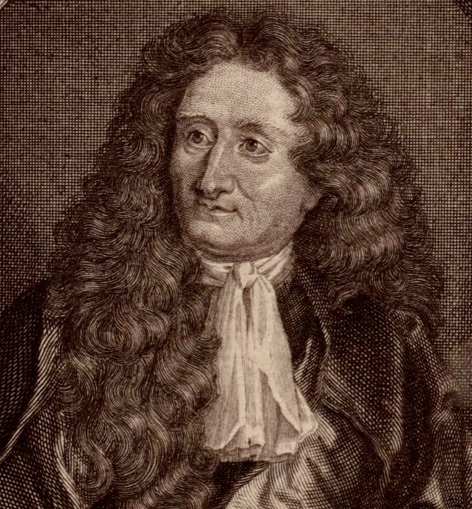
At the end of the 19th century, a French goldsmith made a set of thimbles illustrating the de la Fontaine fables. It is said that these thimbles were so sought after that they were re-issued some 20–30 years later (1) although this has not been confirmed. They were then re-issued from the original dies in the 1970s (2). According to the traditional ‘wisdom’ of thimble collectors, the original thimbles were made by P. Lenain and Co. (according to many Anglo-Saxon writers the ‘P’ stood for ‘Pierre’ (3, 4, 5, 6, 7, 8)), Parisian gold and silversmiths, and they were then re-issued by the same ‘P. Lenain’, using the original dies, some 70 years later (5, 7). This is the ‘Fable of P. Lenain’ but could this story be possible? We think that it is most unlikely.
In order to become a master goldsmith in France, the would-be master had to demonstrate competence and good morality and possess a die stamp with which to mark his work (9). He then had to submit an impression of the die on a copper plate together with details relating to his morality and competence to the appropriate French authorities. Only when the design on the die had been approved could it be used. If ‘P. Lenain’ had made the original de la Fontaine fable thimbles he would have had to be at least 20 years of age, and probably older, when he became a master which would mean that he would have been at least 90 years old when he re-issued the same thimbles in the 1970s. This seems to be a little improbable.
Further evidence against the ‘Fable of P. Lenain’ comes from illustrations of the de la Fontaine fable thimbles in a Maison Lorillon catalogue (10, 11) from the late 19th century.

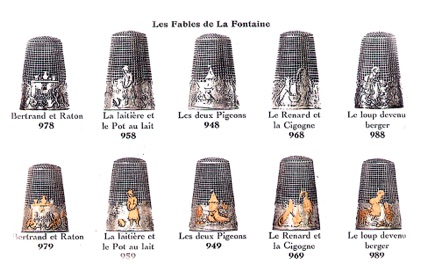
Maison Lorillon was one of the biggest thimble producing companies in Paris at the time. De la Fontaine fable thimbles from this time have been found with a Lorillon mark (‘RL’ separated by a buffalo).
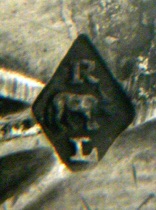
The Lenain mark however, registered at the time, was that of Louis Lenain (12), two interlaced ‘L’s, one reversed.
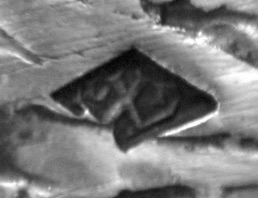
This mark has not been found on any of the original late 19th century de la Fontaine fable thimbles. The mark of ‘Lenain Frères’, LF separated by two interlaced ‘L’s, one reversed, was not registered until 1929 and so could not possibly be found on an original de la Fontaine fable thimble. ‘Lenain Frères’ became ‘Lenain et Cie.’ in 1938 but retained the same mark which, of course, could not have been found on the original the de la Fontaine thimbles either. It is thus much more likely that the original thimbles were made by Maison Lorillon, in Paris, in the late 19th century and not by ‘P. Lenain’, who would have been too young at the time. The ‘Lenain fable’, for this reason alone, becomes untenable and this has been confirmed independently to us recently (personal communication, G Chaplier).
The houses of Lorillon and A Féau (Maison Féau was another big Parisian thimble making house) were amalgamated at the beginning of the 20th century and then in 1950 they moved into premises previously occupied by the Lenain company (13). In the 1950s thimble production was gradually falling in France and so in 1964 Roger Lenain, Louis Lenain’s grandson, who was trying to revive thimble production at ‘Orfèvrerie Lenain’, purchased the Lorillon/Féau company together (13) with all of the original dies. He then re-issued the de la Fontaine fable thimbles together with many of the other Lorillon/Féau designs in the 1970s. These re-issues were meant primarily for the American market. Roger Lenain used his father’s master’s mark on all these thimbles – ‘LF’ separated by two interlaced ‘L’s, one reversed. These thimbles also had a size number, the word ‘France’ and the Mercury head export assay mark since the thimbles were destined for the American market. They were gilded inside and may be seen in a colour photograph taken by ‘Photomatic-Lyon’ in an ‘Orfèvrerie Lenain’ catalogue of the time (14, 15). They are neatly laid out in the photograph and the inside gilding is clearly visible.
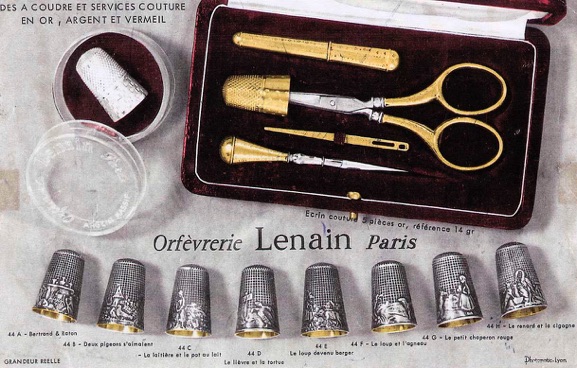
This catalogue with the de la Fontaine fable thimbles could not have been made at the beginning of the century, as has been suggested (15), because commercial colour photography only developed during the 1950s and 1960s. The thimbles illustrated must thus have been the re-issued thimbles
It might be argued that Roger Lenain used his father’s mark to give greater antiquity and authenticity to the re-issued thimbles, but this seems to be unlikely since ‘France’ and a size number were also stamped on to the thimbles and these latter were clearly not present on the originals. They were added for the American market and the old Lenain mark was used because Roger Lenain did not have a registered mark of his own (personal communication, Roger Lenain). Re-Issued thimbles for the domestic market had the Lenain et Cie. mark and a crab – the silver guarantee mark for Paris and the provinces after 1962.
In the light of our findings it would seem that there is very good evidence that the original de la Fontaine fable thimbles were made by Maison Lorillon, many bearing the Lorillon mark, and that following purchase of the Lorillon/Féau company by Roger Lenain in the 1960s the de la Fontaine fable thimbles were re-issued by him using a Lenain master’s mark in the 1970s. It thus appears that the linking of ‘P. Lenain’ to the original production of the de la Fontaine fable thimbles is, in fact, a mistake, but how could this come about?
One of the problems with the old de la Fontaine fable thimbles is that the master’s mark is either poorly stamped or it has become rubbed with time and is thus rendered illegible. It is therefore very difficult to attribute a maker to a particular thimble and it is suggested that thimble collectors, over the years, may have responded to this problem by assigning ‘generic’ makers to an unreadable maker’s mark e.g. ‘P. Lenain and Co.’, ‘P. Lenain’ or ‘Pierre Lenain’. This seems to have been particularly true of the de la Fontaine fable thimbles.
The thimble literature is, generally, relatively sparse and detailed references to claims made regarding thimble makers etc are seldom given. Because of the paucity of information regarding the history of continental thimble makers English authors, whilst describing and depicting the de la Fontaine fable thimbles, do not usually attempt to attribute them to a particular maker. Holmes shows pictures of de la Fontaine fable thimbles that are simply described as ‘French’ (16). McConnel, although mentioning ‘P. Lenain’, does not associate the name with the de la Fontaine fable thimbles (1). There is no mention of ‘P. Lenain’ in two French thimble texts (17,18). Early American authors similarly do not associate the name of Lenain with the de la Fontaine fable thimbles (19).
The first reference to link ‘P. Lenain’ and de la Fontaine fable thimbles, in the thimble literature, is to be found in von Hoelle (20) and it is suggested that this is based on information from Mrs. Rosalind Belford (‘Sewing Corner’ and later ‘Collectors Choice’) and the fact that it was known, at the time, that the re-issued de la Fontaine fable thimbles were made by ‘Orfèvrerie Lenain’ (14). Von Hoelle probably assumed that the same company made the original thimbles. There was no mention of the Maison Lorillon in von Hoelle and probably he did not know of the Lorillon catalogue showing the de la Fontaine fable thimbles. The ‘Lenain fable’ is compounded in Zalkin (21) who probably based her information on von Hoelle. The name ‘Pierre’ Lenain seems to first appear in the thimble literature in 1992 (3, 4). It is repeated by several Dutch and German writers but no references regarding the origin of the name were cited in any of the papers (5, 6, 7, 8). Frank (22), writing about ‘Pierre’ Lenain, states that ‘Lenain is probably the best known French thimble maker in the United States thanks to the re-issue in the 1970’s of some of the thimbles with waffled knurling’. Whilst this statement may well be true, it does not make ‘Pierre’ Lenain the maker of the original de la Fontaine fable thimbles. Frank clearly does not make this claim but her statement regarding the fame of Lenain probably explains the widely held view linking ‘Pierre Lenain’ to the de la Fontaine fable and other French thimbles in America although it is known that Philippe Lenain (Roger Lenain’s father and possibly the ‘P. Lenain’ in the Anglo-Saxon thimble literature) was not interested in making thimbles (personal communication, G Chaplier). The original information linking ‘P. Lenain’ to the de la Fontaine fable thimbles, in the American literature, may be attributed to Mrs. Rosalind Belford who seems to have commissioned the 1970s re-issues of the de la Fontaine fable and other thimbles (2) for the American market (personal communication, B Frank).
That the original de la Fontaine fable thimbles were made by Lorillon from Lorillon/Féau dies and not by ‘P. Lenain’ can no longer be in doubt. There are, however, some de la Fontaine fable thimbles from the early 20th century with a ‘PL’ separated by a thimble master’s mark but there has been no evidence, found so far, to suggest that it belongs to a ‘Pierre’ Lenain. It is most probably another Lorillon mark or the mark of a Lorillon ‘finisher’. We have been unable to find or identify any mark registered for a ‘Pierre’ Lenain although, by law, had a ‘Pierre’ Lenain been making silver thimbles at this time he would have been required to mark thimbles made by him with his own registered mark. Another mark found on early de la Fontaine fable thimbles is that of Jean Levy, ‘JL’ separated by a ladder, and it is thought that this company may have finished thimbles obtained from Maison Lorillon also.
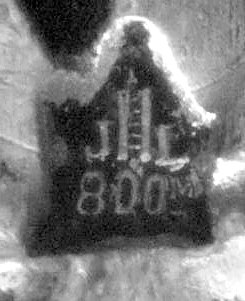
The seed of the ‘Fable of P. Lenain’ was thus planted by Belford, nurtured by von Hoelle, reinforced by Lundquist, augmented by Holmes and perpetuated by many Dutch, German and American writers. We have been unable to find any documented evidence to suggests that ‘P. Lenain’ was the original maker of the de la Fontaine fable thimbles and, in fact, all existing evidence is against this suggestion. It is probable that the ‘Lenain fable’ did originate in America though, following the re-issue of the de la Fontaine fable thimbles about 70 years after their original production in France. This re-issue followed the purchase of the Lorillon/Féau company in 1964 by Philippe Lenain’s son (13). The Lenain company is thus clearly not the originator of the de la Fontaine fable thimbles and was only able to become involved in their production following the purchase of the original Lorillon/Féau dies. Neither Louis Lenain nor Philippe Lenain made thimbles themselves (personal communication, Roger Lenain).
The moral of this story is that it can be dangerous to make an unsubstantiated claim because it can easily become incorporated into the literature and soon come to be regarded as fact. It is all too easy to make a claim, it is much more difficult and much more work to substantiate it. As Betty Aardewerk has said ‘’One cannot always go by what is described in one or even two books. Check, re-check and go as closely as possible to a period source!’’ (23). It would seem that those who perpetuated the ‘Fable of P. Lenain’ sadly failed in this respect.
Acknowledgements:
We are especially thankful to the people listed below who responded promptly to our many questions:
Ghislaine Chaplier who answered many emails and communicated with Monsieur Roger Lenain.
Michel Painsonneau who shared his knowledge of French thimble making history with us and who managed to get information from the Chef de la Cellule Technique de Garantie de Paris (Bureau of Garantie of Paris, Bureau of Customs, Paris).
Wolf-Dieter Scholz who made his vast library of references available to us.
Beryl Frank who shared her reference sources.
Table:
Arguments (pro and con) in favor of P. Lenain as maker of original de la Fontaine fable thimbles (late 19th early 20th century)

References:
1. McConnel B. The story of the thimble. Atglen, PA.: Schiffer Publishing Ltd, 1997. pp. 113.
2. Belfford R. French Silver Thimbles. Silver, 1979: July-August: 34.
3. Holmes EF. Thimble Notes and Queries 1992; 17: 13.
4. Holmes EF. Thimble Notes and Queries 1992; 18: 18.
5. Kamp F, Die Fabelfingerhüte von Pierre Lenain. Vingerhoedniews, 1995, 34: 4.
6. Langedijk CA. Das Missverständnis um zwei goldene Fingerhüte. Rund um den Fingerhut, 2001;33: 4.
7. Sullivan K. Thimbles. Antique Collecting, 2004; 39 (2): 24.
8. Mohr G. Günter Mohr stellt Sammler vor (2). Rund um den Fingerhut 1989; 10:19.
9. Holmes EF. Paris gold and silver thimble makers 1798-1838. Thimble Notes and Queries 1993; 19: 10.
10. Crestin-Billet F. Ouvrages de dames. Paris: Tana, 2005. pp. 68.
11. Crestin-Billet F. Ouvrages de dames. Paris: Tana, 2005. pp. 74.
12. Poinçon des auteurs. Available from:
http://www.culture.gouv.fr/public/mistral/marque_fr?ACTION=RETOUR
&USRNAME=nobody&USRPWD=4%24%2534P
13. Crestin-Billet F. Ouvrages de dames. Paris: Tana, 2005. pp. 74-77.
14. Crestin-Billet F. Ouvrages de dames. Paris: Tana, 2005. pp. 77.
15. McConnel B. Thimble Society Magazine, 2006; 9 (12): 21.
16. Holmes EF. A history of thimbles. London: Cornwall Books, 1985. pp. 69.
17. Crestin-Billet F. La folie des Des a Coudre. Paris: Flammarion, 2003.
18. Crestin-Billet F. Ouvrages de dames. Paris: Tana, 2005.
19. Lundquist M. Thimble treasury. Des Moins: Wallace-Homestead Book Company, 1975
20. von Hoelle JJ. Thimble collector’s encyclopedia. Illinois: Wallace-Homestead Book Company, 1986. pp. 134.
21. Zalkin E. Zalkin’s Handbook of Thimbles & Sewing Implements, 1st edn. Willow Grove: Warman Publishing Co., Inc., 1985. pp. 36
22. Frank B. Thimbles of France with waffled knurling. Thimble Collectors International. USA. 2003.
23. Aardewerk B. The famous Vernon thimble. Thimble Society Magazine, 1992; 4(6): 4.
TCI Bulletin Fall 2007
Holmes: ‘Thimbles in France’ pp. 65.
Researched and published in 2002/11
Copyright@2011. All Rights Reserved
Magdalena and William Isbister, Moosbach, Germany
the fable of ‘pierre lenain’
Navigation
